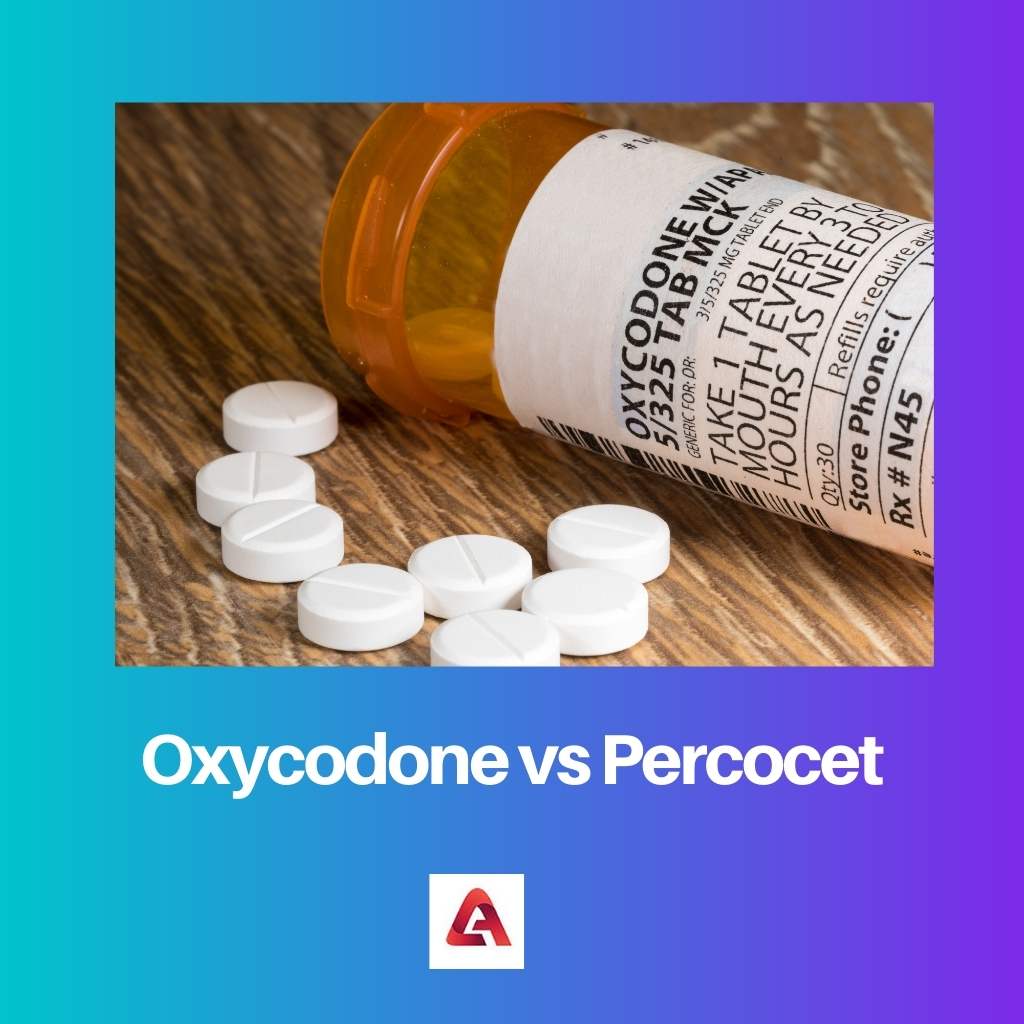Several drugs have been introduced, from natural products such as opium to synthetic drugs like methadone. However, narcotic drugs, in other words, Narcotic analgesics, are always exercised under the control of certified professionals and used as pain relievers.
Key Takeaways
- Oxycodone is a powerful pain reliever used to manage moderate to severe pain.
- Percocet is a combination of oxycodone and acetaminophen used to manage pain and reduce fever.
- The main difference between Oxycodone and Percocet is that Percocet contains an additional ingredient, acetaminophen, which enhances its effectiveness as a pain reliever.
Oxycodone vs Percocet
Oxycodone is an opioid pain medication that is used to manage moderate to severe pain. It works by binding to specific receptors in the brain and spinal cord to decrease the perception of pain. Percocet is a combination medication that contains oxycodone and acetaminophen, a non-opioid pain reliever. Acetaminophen is added to enhance the pain-relieving effects of oxycodone and reduce fever.

Oxycodone is a pain medication in the family of opioids. Following that, Thebaine is the progenitor of Oxycodone, which was founded in Germany in 1916 as a part of the Opioid drug family.
On the other hand, Percocet is also a type of narcotic drug, but four combinations of Oxycodone with acetaminophen together produce Percocet. It is used in short-term pain-relieving cases.
Comparison Table
| Parameters of Comparison | Oxycodone | Percocet |
|---|---|---|
| Definition | Oxycodone is a narcotic drug issued as a pain relief mediation, which aids to manage by assuaging severe acute or invertebrate pain. Oxycodone is a pain medication among the family of opioids. | Percocet is a narcotic drug that mixes four combinations of Oxycodone with acetaminophen together to produce Percocet for tempering short-term pain. |
| Etymology | Oxycodone originated from Thebaine in Germany in 1916 as quality life pain relief generic mediation. | Percocet is also a part of the drug family termed as Opioids, which got approved in 1976 by the US FDA. |
| Purpose | Oxycodone is made for moderate-severe pain which may direct the human brain to respond to the pain and ameliorate the quality of life in terms of pain. | Percocet is created to mollify short-term pain or suffering. The combination of Oxycodone and Acetaminophen undermine pain and also eliminates the feverish feeling that is caused by the pain. |
| Side Effects | Constipation, Dizziness, Vomiting, Headache, sweating, trembling, loss of appetite, nausea, respiratory problems, bradycardia, low Bp and hallucination, etc. may cause oxycodone overdoses. | Mercurial or mood swings, Headache, Drowsiness, dizziness, stomach ache, nausea, vomiting, shortness of breath, constipation, and fever, etc. |
| Legal in | Countries like Canada, Hong Kong, Japan, Australia, UK, the USA, Singapore, and Germany tolerate the consumption of Oxycodone only under the prescription of medical terms. | Percocet is legal in the USA, UK, India, Pakistan, Japan, Germany, Vietnam, Iran, Brazil, China, Thailand, Mexico, Egypt, Turkey, Russia, Bangladesh, Philippines, Nigeria, and Indonesia |
| Age criteria | It is sanctioned that the use of Oxycodone can be prescribed above 11 years of age. | Percocet highly recommends not to consume by those, who are under 18 years old. |
What is Oxycodone?
Oxycodone is a well-known narcotic drug that is issued as a pain relief medication in various operations undertaken by doctors.
Subsequently, oxycodone was legalized in various countries, such as Canada, Hong Kong, Japan, Australia, the UK, the USA, Singapore, and Germany.
Oxycodone is made for moderate-severe pain, which may direct the human brain to respond to the pain and ameliorate the quality of life in terms of pain for short-term operations.
However, overdose engenders an addiction to Oxycodone, besides the other risk factors like Constipation, Dizziness, Vomiting, Headache, sweating, trembling, loss of appetite, nausea, respiratory problems, bradycardia, low Bp, and hallucinations.

What is Percocet?
On the other hand, Percocet is also a type of narcotic drug, but four combinations of Oxycodone with acetaminophen together produce Percocet.
To put it in simple words, Percocet is created to reduce short-term pain or agony. The combination of Oxycodone and Acetaminophen undermines pain and also eliminates the feverish feeling that is caused by the pain.
On the whole, Percocet medications are prescribed under the guidelines of professionals as a pain-killer for minor surgeries.

Main Differences Between Oxycodone and Percocet
- Oxycodone is applicable above 11 years of age, whereas Percocet is obliged not to consume under the age group of 18 years old as the ingredients added to create Percocet is quite effective in narcotic substance.
- Oxycodone is illegal in some countries as it engenders parlous addiction ion to the medicine, albeit Percocet is quite popular in usage for short-term pain relief and legal in the Philippines, Nigeria, Vietnam, Iran, Brazil, China, Thailand, Mexico, Egypt, Turkey, Russia, Bangladesh, and Indonesia, etc.




